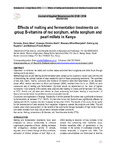Effects of malting and fermentation treatments on group B-vitamins of red sorghum, white sorghum and pearl millets in Kenya

View/
Date
2010Author
Ochanda, Simon Oduor
Akoth, Onyango Christine
Mwasaru, Alfred Mwanjallah
Kagwiria, Ochieng Joy
Mathooko, Francis Mutiso
Metadata
Show full item recordAbstract
Objectives: To enhance the safety and nutritive values and shelf life of sorghums and millet flours through malting and fermentation. Methodology and results: Malting and fermentation were carried out for a period of seven days with the aim of determining the optimal number of days needed for each of these processing treatments. The quantities of folic acid, niacin, thiamin, pyridoxine and riboflavin (B-vitamins) were then determined by the reversed-phase HPLC method described by Ekinci and Kadakal (2005), modified from Cho et al., (2000) on each successive day of malting and fermentation. Optimum results as determined on the basis of highest increments in the contents of B-vitamins were obtained after malting for 3 days and fermentation for 2 days, at 25°C. Acidity and pH were also altered by these processing techniques leading to improvement of flavour and aroma shown by preliminary sensory evaluation results. Conclusion and application of findings:Availability of all the selected B-vitamins was significantly enhanced by fermentation by between 71.2 - 94.2%. On the other hand only riboflavin was significantly affected by malting with 44.2% increase, the rest increased by less than 10.5%. The results of this study will be useful for the development of new products from neglected indigenous cereals like sorghum and millet. This will enable value chain development for the benefit of the community through realization of high nutrient foods and better incomes from crops that do well in adverse climatic conditions.
